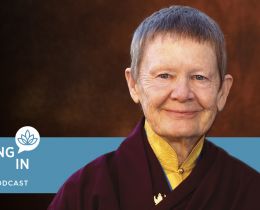In his teachings on compassion, the Buddha encouraged us to develop “a mind so filled with love it resembles space.” Can you picture your mind being as limitless, unconstrained, free, and open as space? Spaciousness of mind and heart is a fundamental component of a resilient spirit. It brings us a kind of well-being that isn’t dependent on the successes or failures we encounter on any given day. Unconditional well-being does not exclude pain but surrounds it with wisdom and love. This radical kind of happiness is the antidote to suffering. And it is available to us at any time and even in the most unlikely circumstances.
Consider what’s happening at one of America’s highest-security prisons, deep in the Bible Belt in Alabama. The state’s most violent and mentally unstable male prisoners are incarcerated in the William E. Donaldson Correctional Facility outside Birmingham. About a third of the 1,500 or so prisoners have lifetime sentences with no chance of parole, and 24 of the cells are reserved for death row. Donaldson has a history of inmate violence—both between inmates and against the prison staff. In fact, in some areas of the facility, meals are slid into inmates’ cells through narrow metal boxes in the doors in order to protect the officers delivering the food.
As harsh and violent as life is in the cell blocks, inside the prison gym, it’s a different story. Three times a year, for ten days, the gym is transformed into a hall for Vipassana, or Insight Meditation. (A follow-up 3-day retreat is held once a year.) For the duration, two dozen or so inmates rise at 4:00 a.m. and retire at 9:00 p.m., meditating for much of the 17 hours in between. Led by volunteers from S. N. Goenka’s Prison Trust, they eat a strict vegetarian diet, abstain from smoking, neither read nor write, and observe total silence. Apart from the occasional one-on-one with a teacher, the only “conversation” consists of the inmates’ internal dialogue or examination of what’s going on in their bodies and minds.
“It’s a rude awakening for some prisoners,” one of the teachers, Carl Franz, told a reporter for NPR’s Morning Edition. “Everyone’s mind is a kind of Pandora’s Box, and when you have 33 rather serious convicts facing their past and their own minds, their memories, their regrets, rough childhood, their crimes, lots of stuff comes up.”
That said, the transformations are remarkable. “Before I went to a Vipassana Meditation...I was probably the angriest man in this prison,” said a convicted murderer named Grady Bankhead, who came within hours of being executed before his sentence was reduced to life imprisonment and he was moved off death row. He had reason to be angry. When Bankhead was three years old, his mother left him and his little brother in a farmhouse, telling them she would be back soon. He didn’t see her again until he landed on death row. Meantime, his brother had died. Meditation helped Bankhead get to the root of his anger. Now he’s recruiting other inmates to take the challenging course. “We have to have some kind of balance back in our lives from the horrible things that we’ve done,” Bankhead said. Another inmate agreed, “Meditation changed my life.”
Like the meditating inmates, we can come to understand that we don’t have to live beset by constant turbulence and anxiety and regret. We may be incarcerated in a prison of our own making, but we can spring the lock and live in greater peace and serenity and joy.
The practice of compassion reminds us that we are larger than our anger, our misfortune, and even our pain. Because we have suffered, we want to make this a better world, and we can act without timidity or equivocation. Our vision of life can become vast, fueled by compelling moral force.










